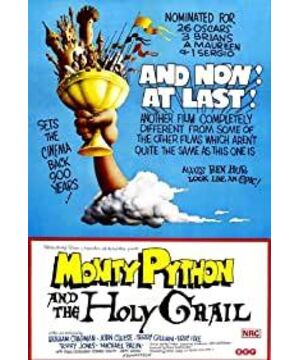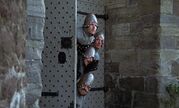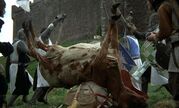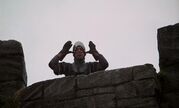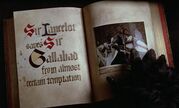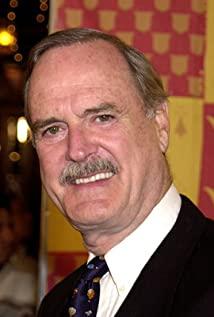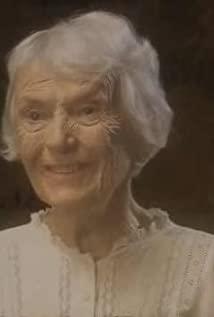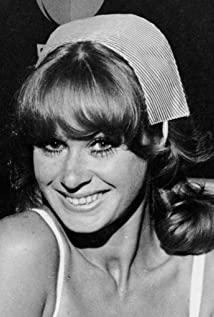By 1974, with the sensation of drama series, derivative products and stage tours, the Python group became popular in the island country, and the time to plan a new movie was ripe. Although John Cleese announced his withdrawal from the fourth season of the series, he still readily agreed to the film plan. According to the old rules, the six members sat together and started to provoke the jokes. Michael Palin’s King Arthur and servants won unanimous praise for their creative ideas of coconut horses. This triggered and determined to build a movie script based on King Arthur’s adventures, "Monty Anaconda and the Holy Grail" (Monty). Python and the Holy Grail) was born.
The six Pythons who have never written movie scripts retain the way of writing TV dramas-each accumulates sketches, and then integrates them to organize the main line. The final script is based on the main line of King Arthur summoning the people to find the Holy Grail and the knights to venture separately The secondary thread is interwoven. The casting of the cast generally follows the tradition of the drama-whoever writes the joke is allowed to act; Graham Chapman, who is born with a noble straight male face and the expression of a suffering saint, has become the best choice to play King Arthur. When it came to the director, it was obvious that only Terry Jones and Terry Gilliam were interested, and the burden naturally fell on them.
With the script, the money became a problem. At first it was two rookies who directed them by themselves, and the film companies were all scared away. Finally, thanks to the help of adventurous producer Michael White: he raised one hundred thousand pounds from National Film Finance Corporation, plus Python record owner Charisma Records pulled one hundred thousand from its bands Led Zeppelin, Pink Floyd, Genesis, etc. Investment, the movie finally started. Less money is also good-the idea of using coconut as a horse is automatically retained, and the coconut shell has become the best collection for holy grail fans today.
Once the money was in place, the two directors, Terry, embarked on a two-week tour around Britain, looking for locations for the film, and finally finalized several Scottish castles. Just a week before filming started, the Scottish Environment Agency issued a ban, stating that the content of the film was not commensurate with the nobleness of these buildings. The two Terry were forced to travel again and selected two other Scottish castles at the last minute before construction: Doune Castle and Castle Stalker.
At the end of April, the filming work officially started. Trouble ensues one after another on the first day: The filming that day was a Death Canyon scene, and the crew asked a local expert to build a wooden bridge across the canyon. It seemed dangerous, but it was actually very reliable. Everyone relied on the mountain climber Graham Chapman to take the lead, but at the shooting scene, King Arthur stood by the canyon after a hangover and trembles all over the bridge. Delirium tremens). John Cleese also did not dare to cross the bridge, because the leather soles were too slippery. As a last resort, these two shots used a stand-in. The bigger trouble lies behind: the two Terry only took the first shot of the director's career, and the only main camera that recorded the sound at the same time ceased fire, and all the gears fell off as soon as they were turned on. The scene at the canyon can't be filmed anymore, so I can only shoot close-up shots at the other end. But the big guy didn't dare to cross the bridge directly, so he took a few close-up shots on the other side after going around in circles.
This kind of discomfort continued throughout the filming period. The cold and humid weather in Scotland, the crude and uncomfortable costumes, and the alcoholic King Arthur who couldn't remember a few lines, all made everyone suffer. The hotel where the crew stayed can only supply hot water for six adults. After more than a dozen hours of filming a day, a large group of people had to rush back to the hotel to take a hot bath. Cleese and Idle finally couldn't bear it and moved into another hotel, just as the beauties who filmed the "Anthrax Castle" scene were moved in collectively, and finally a glimmer of light appeared in the dark tunnel.
As directors, the two Terrys have similar aesthetic ideas and are both fans of Pasolini. They want to make a dirty, crazy, and believable medieval movie, rather than the super-real classic Hollywood movie. During the on-site guidance, the two have their own strengths. Jones, who is an actor, is more experienced in comedy. Gilliam, who has been an animator for several years, has a stronger visual sense. The shot of the keel boat approaching King Arthur is a typical Gilliam-style magical brushwork, theory It is said that this is a complementary combination. During the filming, the two worked closely together and divided the conversation rights by day on the schedule. The scheduling was still harmonious and effective. As Gilliam's perfectionism and the limited time and budget contradiction of the crew gradually intensified, Jones, who worked quickly, began to fight for control on Gilliam Day, and the rift between the two gradually became apparent.
Terry Gilliam was accustomed to dealing with paper-cutting and photographs when he was doing animation, and everything could be left at his mercy until he was completely satisfied; when he copied this perfectionism to filming, he encountered strong resistance from fellow pythons: shooting that poultry. During the defense battle, Cleese, who was instructed to move left and right repeatedly, scolded on the spot, "We are not a few pieces of paper-cutting", and Gilliam was so angry that he sulked in the corner alone for several hours; filmed "Bring out the dead". At the scene, the village where the corpse truck passed by was muddy, and Michael Palin played a villager who was crawling and gnawing on the mud in the background. Even in the role of the masses, Gilliam did not relax, shooting eight straight shots of the crawling passage. At the end of the seventh article, Palin thought he was over, but what he heard was, "Do it again, Michael showed his back in that article..." Palin, who is recognized as the best tempered, finally went mad and roared wildly. For five full seconds, Cleese and Graham drew a round of applause. Finally the mud was about to be gnawed, and the prop master consoled Palin that it would be chocolate. When Palin asked how to distinguish between chocolate and mud, no one answered immediately. When the final shot was over, Palin ate chocolate, but there was also a lot of mud mixed in. Michael Palin, who was wearing a rag and rotten shirt and covered in mud, ran to break the cold shot and frightened the Scottish Barefoot Doctor. The climax of the tragedy is at night: a group of people gather to watch the sample, and there is no Palin shadow in the whole scene! As the conflict between Gilliam and his colleagues intensified, the two directors simply divided the work: Jones was in charge of the python helper, and Gilliam only dealt with the technical team.
In addition to the awkwardness of the two first directors, the unprofessional production of the independent production also brought a lot of trouble to the shooting: in order to film the scene of Lancelot's wedding, the production designer carefully designed a whole set of stairs in the castle. The two Terry looked at each other and praised. The next day they entered the castle to start the machine, and the two of them were dumbfounded. The whole castle was empty, except for the stairs. When I asked the art director back, he said that decorating the interior is the job of the set dresser. There was no way, the two directors had to move the table and put the flags on their own, and finished the whole set of scenes. Facing the chaotic shooting scene, Terry Jones set a motto for himself: "Don't Panic"-this is far before the bizarre book "The Hitchhiker's Guide to the Galaxy" (radio drama) was born.
After six weeks of hard work, "Monkey Python and the Holy Grail" finally came to an end. The end of the movie is Eric Idle's magical touch: Arthur's Army is composed of a group of college student extras. The salary is only four pounds a day, and the number of people is very limited. It is impossible to arrange a battle. The Pythons took all the angles that could be taken, and then used the post-modern way of police breaking into the camera to end the film, which also perfectly followed the Monty Python label that did not have a punchline during the "Flying Circus" period.
In the editing room, the two Terry's differences reappeared: Gilliam believed that Jones had injected too many emotional memories of shooting on the spot when choosing, and lacked objectivity. The argument was not out of date, and Gilliam simply sneaked back to the editing room at night to make changes.
On October 1, in front of more than one hundred investors, relatives and friends, "Monkey Python and the Holy Grail" made the first trial screening. The result was disastrous. Five minutes before the opening, there was continuous laughter, and it slowly became silent until the end of the show. The mixing is too real, the rhythm is not tight enough, and the poor quality of the screening is the main reason for the failure. The Pythons were not discouraged. Terry Jones went back and redoed the soundtrack, erasing the background sound of the dialogue one by one, making the jokes clearer and more undisturbed; the cutscene was added with a magnificent soundtrack and a mocking epic taste; The feedback of the 13 free trial screenings has been revised, and the rhythm of the film has been tightened again and again. When participating in the Los Angeles Film Festival, facing the audience who bought tickets, "Monkey Python and the Holy Grail" finally had its first successful screening.
On January 10, 1975, "The Python and the Holy Grail" held a grand premiere in London. The unsure Pythons were nervous, and King Arthur Chapman was scared and confused on the spot. Fortunately, the premiere was an instant hit, and the film went viral throughout the UK, even if the film reviews were consistently harsh. Five months later, the film made its North American premiere in New York and Los Angeles. At that time, "Flying Circus" was hitting the PBS television network. The rush of Lao Mei blocked the theater gates, and the audience queued for admission. There are many future stars like Chevy Chase and Jim Belushi.
Monty Python suddenly became the god of comedy in the eyes of Americans, and a new "British Invasion" myth was forged.
A lot of behind-the-scenes pictures can be viewed here
http://ethermetic.com/archives/2699
View more about Monty Python and the Holy Grail reviews


